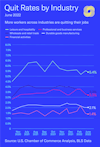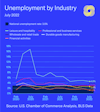Understanding America’s Labor Shortage: The Most Impacted Industries

The pandemic caused a major disruption in America’s labor force—something many have referred to as The Great Resignation. In 2021, more than 47 million workers quit their jobs, many of whom were in search of an improved work-life balance and flexibility, increased compensation, and a strong company culture.
But a closer look at what has happened to the labor force can be better described as ‘The Great Reshuffle’ because hiring rates have outpaced quit rates since November of 2020. So, many workers are quitting their jobs—but many are getting re-hired elsewhere.
The U.S. Chamber is capturing the trends on job openings, labor force participation, quit rates, and more, for a quick understanding of the state of the workforce in our America Works Data Center.
Read on for an analysis of which industries have been impacted the most. For an in-depth look at how the worker shortage is impacting the nation overall, click here.
Food service and hospitality struggle to retain workers
During the pandemic reshuffling, jobs that require in-person attendance and traditionally have lower wages, have had a more difficult time retaining workers. For example, the leisure and hospitality and retail industries have had the highest quit rates since November 2020, consistently above 4.5 percent.
But at the same time, the hiring rate has been even higher. Leisure and hospitality lost 1 million workers in November 2021, but 1.2 million people were hired into the industry that same month. In fact, leisure and hospitality has maintained the highest hiring rate of all industries since November 2020 at 8.1 percent. This is compared to the national hiring rate which has hovered recently around 4.4 percent.
When taking a look at the labor shortage across different industries, the transportation, health care and social assistance, and the accommodation and food sectors have had the highest numbers of job openings.
But yet, despite the high number of job openings, transportation and the health care and social assistance sectors have maintained relatively low quit rates. The food sector, on the other hand, struggles to retain workers and has experienced consistently high quit rates.
Meanwhile, in more stable, higher paying industries, the number of employees quitting has been lower.

A closer look at labor force participation
To further understand shifts in the labor force, it is interesting to look at labor force participation across different industries. Some have a shortage of labor, while others have a surplus of workers.
For example, durable goods manufacturing, wholesale and retail trade, and education and health services have a labor shortage—these industries have more unfilled job openings than unemployed workers with experience in their respective industry. Even if every unemployed person with experience in the durable goods manufacturing industry were employed, the industry would only fill 65% of the vacant jobs.
Conversely, in the transportation, construction, and mining industries, there is a labor surplus. There are more unemployed workers with experience in their respective industry than there are open jobs.
The manufacturing industry faced a major setback after losing roughly 1.4 million jobs at the onset of the pandemic. Since then, the industry has struggled to hire entry level and skilled workers alike.

Remote work has changed the game
Some industries have been less impacted by labor shortages but are grappling with how to deal with the rise of remote work. For example, the rise of remote work might explain why there has been less “reshuffling” in business and professional services.
Gallop found that 91% of U.S. workers hoped they could continue working some of their hours from home, and three in 10 workers signaled they would seek new employment if they were recalled to the office.
The business and professional services industry has had lower unemployment rates and has maintained above average hiring rates. More than 1.2 million people were hired into the industry every month between July 2021 and November 2021.

Two years ago, finance, management, professional services, and IT/telecommunication jobs were expected to have the highest potential for remote work. That has proven to be true as more than half of traditionally white-collar workers were still working from home part at least part time in spring of 2021.
To remain competitive and attract new talent, employers have started to shift their corporate models. Many businesses have embraced remote or hybrid work models and flexible scheduling. Yet, no one solution to industry labor shortages or employee retention exists. Nor are any solutions appropriate for all industries or employers.
However, the U.S. Chamber is proud to lead business community in identifying the actions employers can take to offer good jobs to Americans. Businesses can increase their hiring pools by removing barriers to entering the workforce by expanding childcare access and “second-chance” hiring, and provide opportunities for new and existing staff to be upskilled and reskilled on the job.
Learn more about how employer solutions through the Chamber’s America Works initiative here.



